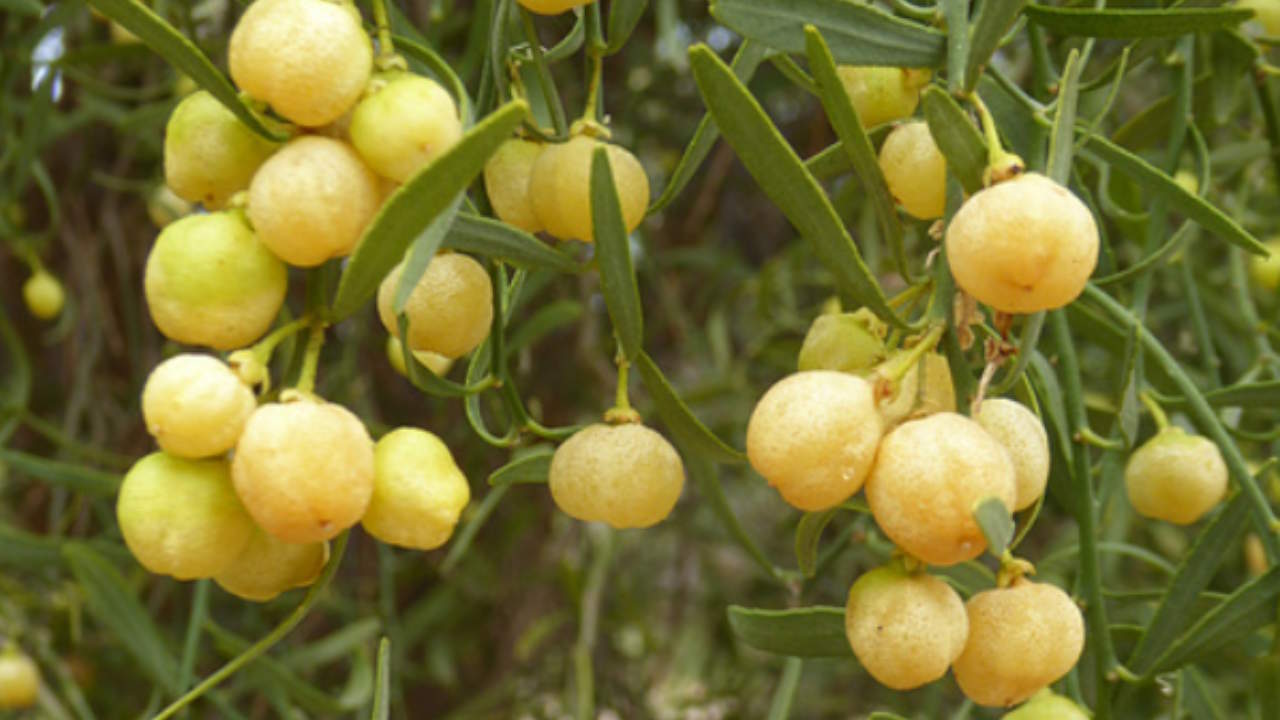Desert Lime
Citrus glauca
Also referred to as “wild lime”or “desert kumquat” , the Desert Lime is a hardy occasionally thorny shrub or small tree producing small green grape-sized fruits. This species is native to inland desert regions of Queensland, New South Wales and South Australia.
This small fruit packs an intensely citrus flavour! As an Aboriginal bush food, they were eaten whole and are today considered a highly prized native fruit high in vitamin C, lutein, folate and vitamin E. You can enjoy Desert Lime in a variety of ways including marmalades, sauces, pickles and chutneys, candied peel, cocktails, and as a flavouring spice for both sweet and savoury dishes.
Fruits will appear soon after a showing of white, sweetly scented flowers in Spring — this fast fruit set is a quirk of the Desert Lime’s adaptation to a desert climate. For best results, harvest only ripe fruits — these will come away easily from the stem when gently pulled. Desert Lime is typically wild-harvested in areas where it’s commonly found, however increasing commercial cultivation will help us reduce the stresses placed on wild bushland by our demand for this delicious little fruit.
Non-grafted Desert Limes show a strong preference for its native desert conditions, so gardeners living in wetter climates and coastal areas should look for grafted cultivars, which will do best in rich, loamy, well-drained soil alongside other backyard bushfood plants. For a more prolific Summer fruiting, mulch around the base of the tree and fertilise lightly with a citrus fertiliser in late Winter. (All Tucker Bush Desert Limes are grafted to make more uniform and vigorous plants, capable of growing in a wider climate and soil profile.)
This plant can grow up to 7m in height eventually, but can be kept at a manageable 3m with pruning as needed. Drought resistant and attractive, it’s a perfect addition to a low-maintenance garden or ornamental courtyard, and may be grown in large pots on a sunny veranda.
Is Desert Lime an endangered species?
No, but we still caution people against foraging in the wild. Desert Limes are relatively common in surviving bushland, but agricultural clearing, pest grazing and climate change means existing wild populations of this plant still need to be conserved. In future, drought-tolerant species like the Desert Lime could help sustain local food production in this country.
Will Desert Lime grow in areas that get frost?
Yes, however this species will need extra care in order to flourish. Protect young trees from the cold and wind. You may even want to grow your young Desert Lime in a large pot (so it can be moved indoors in winter) for its first couple of years, before transplanting it into the ground at the start of Spring. A healthy grafted Desert Lime is frost tolerant once established.
I’ve heard Desert Limes can be thorny, but my tree is thorn-free. Is that normal?
Yes. Stressed Desert Limes grown in harsh conditions typically produce thorns for protection — another interesting evolutionary adaptation. However Desert Limes grown under ideal conditions (such as in a well-kept edible garden) rarely produce as many (if any) thorns. Occasionally, a grafted Desert Lime may grow a thorny “water shoot”, a fast-growing shoot from above the graft point.
Why is my Desert Lime not producing flowers or fruit?
Your plant may not be getting enough sunlight in its current spot; try shifting it to a sunnier position or moving shade objects to allow more light through. If you fertilise your soil, switch to a fertiliser with a lower nitrogen (N) percentage.
How much should I water my Desert Lime?
Despite Desert Lime being a desert native, plants cultivated for home growing are typically grafted onto rootstock suited for wetter (temperate and subtropical) growing conditions. Water generously during the hotter months and ensure the ground around the base of the tree is mulched. If you live in one of the wetter areas of Australia, you may get away with not watering your Desert Lime at all during the winter/wet season.

Suitable for full-sun

Suitable for part-shade

Suitable for pots

Dimensions:
Height 3-6m
Width 2-4m

Tolerates drought

Tolerates sandy soils

Fruits from:
Year 1 onwards

Bird attracting

Attracts bees & insects

Suitable for hedging/screening

Provides shade

